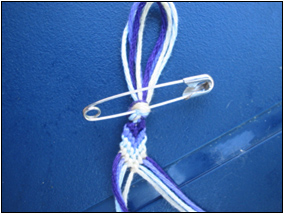
Source: Friendship bracelet, Dicemanic, Flickr
A system of linear equations is two or more linear equations that use two or more variables.
An example of a system of linear equations:
To raise money for Homecoming, the Student Council sold tickets to a basketball game. There was a total of 350 tickets sold. Adult tickets were sold for $3 each, and student tickets were sold for $2 each. The Student Council raised a total of $850.
A solution to a system of linear equations is a pair of numbers for x and y that makes both equations true.
To find a solution to a system of linear equations, one of three methods could be used: substitution, elimination, or graphing. 150 adult tickets were sold, and 200 student tickets were sold. To determine if a solution is reasonable, verify whether the pair of values satisfies the conditions given in the verbal situation.
Total number of tickets sold: 150 + 200 = 350.
Total money raised: 3(150) + 2(200) = $850
Example 1: Iris enjoys making friendship bracelets. She is able to braid a purple bracelet at a rate of 5 cm per day and a green bracelet at a rate of 4 cm per day. The purple bracelet is already 5 cm long and the green bracelet is already 11 cm long. Iris estimated that the two bracelets would be the same length after 4 days. Was her estimate reasonable?

Source: Friendship bracelet, Dicemanic, Flickr
System of equations:
(the length of each bracelet as a function of x days)
L(x) = 5 + 5x → purple bracelet
L(x) = 11 + 4x → green bracelet
To determine the length of the purple bracelet after 4 days, use L(x) = 5 + 5x, or 5 + 5(4) = 25 cm.
To determine the length of the green bracelet after 4 days, use L(x) = 11 + 4x, or 11 + 4(4) = 27 cm.
Therefore, Iris's conclusion was not reasonable since the two bracelets would not be the same length after 4 days.
To determine the number of days needed for the bracelets to reach the same length, use any method of solving the system of equations (substitution, elimination, or graphing).
Solve by substitution:
5 + 5x = 11 + 4x
-4x -4x
5 + x = 11
-5 -5
x = 6
So, the bracelets would be the same length after 6 days.
L(6) = 5 + 5(6) = 35 cm
L(6) = 11 + 4(6) = 35 cm
The bracelets would each be 35 cm after 6 days.
Example 2: Gillian is conducting an experiment for science class. She is adding ice to two glasses of water and recording the temperature of the water every minute for one hour. Glass A started at 80°F and after having ice added, is cooling at a rate of 2 degrees per minute. Glass B started at 95°F and after having ice added, is cooling at a rate of 3 degrees per minute. Gillian hypothesized that the two glasses would reach the same temperature after 15 minutes. Was her hypothesis reasonable?
Systems of equations:
(the temperature of each glass as a function of x minutes)
T(x) = 80 – 2x → glass A
T(x) = 95 – 3x → glass B
To determine the temperature of the water in glass A after 15 minutes, use T(x) = 80 – 2x, or 80 − 2(15) = 50 degrees F.
To determine the temperature of the water in glass B after 15 minutes, use T(x )=95 – 3x, or 95 − 3(15) = 50 degrees F.
Therefore, Gillian's hypothesis was reasonable since the two glasses of water would reach the same temperature after 15 minutes.
After 15 minutes, both glasses of water would reach 50°F.
Example 3: An amusement park charges an entry fee of $10 and an additional $3 per ride. A water park charges no entry fee, but $8 per ride. Kim estimated that if she rode 2 rides at either park, she would spend the same amount of money. Is her estimate reasonable?
System of equations:
(the cost of each park as a function of x rides)
C(x) = 10 + 3x → amusement park
C(x) = 8x → water park
To determine the cost of 2 rides at the amusement park, use C(x) = 10 + 3x, or 10 + 3(2) = $16
To determine the cost of 2 rides at the water park, use C(x) = 8x, or 8(2) = $16.
Therefore, Kim's estimate was reasonable since the cost of 2 rides at both parks is $8.